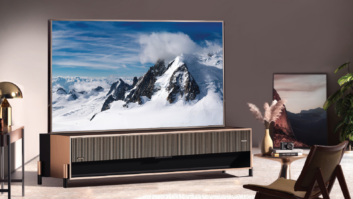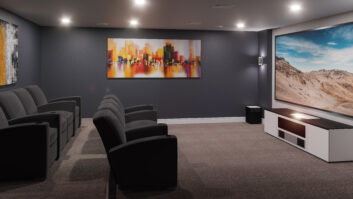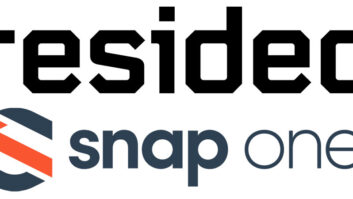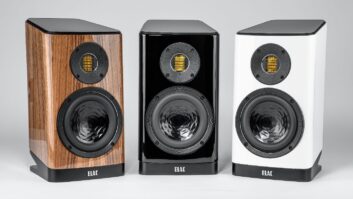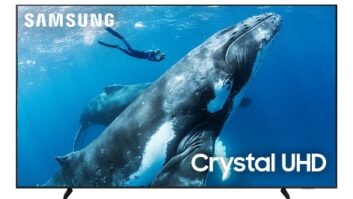In our world of residential systems design and installation, much has happened, which gives us some clues as to how to prepare for the next decade. Imagine, 10 years ago we were all basically at dial-up speed, VCR was still the predominant form of physical distribution for video entertainment content. Ah, how times have changed.
Looking ahead is an interesting, if imprecise task. Here, however, our goal is not so much to predict the future; we’ll leave that to those with crystal balls.
Rather, by viewing the progression of technology from the past to the present we can provide some hints to help you prepare your clients, their installations, and your business for the residential systems technology for the decade ahead.
Michael Heiss
One certainty is that the decade ahead will demand more energy efficiency from all home systems.
Part of that will come from new products, but part of it will also come from how your provision them.
Instead of “brownie” points with clients, instead look for “greenie” points.
It may be easier than you think. One example of that is by making arrangements to not only remove old gear from a retro job, but to prove to the client that their old CRT TVs and computer monitors and any of their old electronic gear is responsibly recycled.
Suffice to say, this is also going to help you in any LEED-certified jobs.
Lighting control is also a key part of energy conservation, where you can use products such as Kill-A-Watt to show that a minor drop in brightness can begin to deliver reasonable energy savings.
Does your staff have the products and training needed to use this to your advantage in the decade ahead?
Beginning as soon as the latter part of 2010, the hype will build around 3D systems well beyond what was seen at CEDIA EXPO and what will be demo’d at CES.
It’s too early to tell which system will “win” this latest format battle, or perhaps if there will even be one dominant format.
Some systems may be compatible with some plasma, some LCD, and some LCoS displays, but no matter what, you also need to a bit of preparation by telling clients that there will almost certainly be additional equipment required.
Beyond the caution on costs to the client, plan now by allowing rack space and power to accommodate possible image processors whose requirements and compatibility just can’t be set today.
Similarly, with some of the 3D systems delivering high-resolution “1080 per eye,” be prepared for the need for higher bandwidth system wide.
Particularly in retrofit or upgrades, make certain that any existing “Category 1” HDMI interconnects are replaced with higher speed “Category 2/High Speed” interconnects.
If you have an installation that is still hanging on to component video connections, the pending arrival of 3D should be the tipping point to go HDMI.
While we wait for the formats to settle in, there are some other ways that you can make a theater environment “3D Ready”.
For example, with the presumption that all 3D systems will require some sort of glasses for the foreseeable future, design some place or means in a theater to neatly hold the glasses when they are not in use.
On that theme, it won’t just be the glasses but the batteries that power them and the cleaners that will be needed to remove fingerprints and such.
Provide a place for that now and your clients will thank you later.
Regardless of whether the content viewed in the second decade of the 21st Century is in 2D or 3D, there is a big cloud hovering over content delivery. A good cloud, that is.
Moving forward we will see and hear more content that is delivered from “cloud-based” services to your clients’ homes that may then be transferred to, or used by a wide variety of devices.
Some we know today. Others will be in products forms not yet available, or in current products that are not yet so ‘net-centric.
How can you prepare ahead when you aren’t sure what the devices are?
For starters, now that the 802.11n standard has finally completed the standardization process, clients who have been waiting for the certainty that any products on that standard will be compatible, the long wait is over.
At the same time, more and more products, particularly laptops and netbooks are offering “n” in their suite of wireless options.
With more content and in-home services becoming ‘net and network-based, think about how that will impact where network access is provided, and how it is delivered.
When calculating the “network load” make certain that wireless coverage with sufficient bandwidth and security is available everywhere it might possibly be needed.
For example, building codes have long specified the availability of AV power outlets in a residence.
Take a clue from that and make sure that any new build, or where possible and appropriate, retro job includes AT LEAST one network connection in each room.
Then, move beyond that and make certain that the network usage is forecast for each room based on the number of television sets, video game consoles, Blu-ray players, media servers, networked digital picture frames, remote cameras/room monitors, thermostats and more.
On the audio side of the fence, it is a bit more difficult to predict what technologies and trends will appear that are not quite visible at the end of this decade, as audio products and technologies tend to have longer life cycle than their cousins in data and video.
On the speaker side, think about where to suggest a subwoofer where there isn’t one now.
Although most consumers think that speakers last forever, surrounds do deteriorate over time, so when doing a “new decade” walkthrough with a client, ask if you can lift the grills on any speakers they now own to see if replacement or at the very least a re-cone for their “can’t part with these old classics”.
It’s too early to tell if the new surround processing systems that add front “height” channels will resonate with consumers, but at the very least consider pre-wiring for them as you plan new installations.
Afterall, with 3D likely to be the biggest consumer draw in consumer electronics over the decade, you could find your own way to incorporate and sell sound that matches the image.
Avoid the hype of trying to make audio “3D Ready”, as for the moment the standards do not call out any specialized addition to audio with the various 3D proposals.
Instead, stick to what works. Good sound always makes pictures look better!
Standards? Did we say standards? That is one thing that would be nice when it comes to IPTV and content access from non-traditional sources in the wild world of “over-the-top”.
The best suggestion for planning on that score, other than yet another plea to have all the network connections you can imagine today — and then to add a few more for safety — is to plan for, or install a computer in any main theater area.
A computer in combination with the likes of Hulu, Boxee, Zinc or services yet to be announced may increasingly be your clients’ portal to “catch-up” viewing for an episode of a favorite show they didn’t watch and forgot to record on the DVR, along with access to “net-only” content from the likes of YouTube.
The deals that Sony and Microsoft are making for direct delivered content from their own sources, as well as through service providers such as Netflix mean that you can’t simply ignore game consoles even when the clients don’t use them for gaming.
Another item to keep in mind is that the nature of the various content deals is such that there is likely to be some exclusivity either to the content itself or to the content in a specific format.
Thus, you may have to explain why someone who might not want a game console at all may need not only one, but two.
Along with suggesting the possibility of multiple games there is the possibility that you’ll further add external content access products such as an AppleTV for those who want electronic delivery of as many movies and services as possible.
As mentioned earlier in the year in our E3 report, all indications are that Microsoft and Sony will introduce motion-based control systems this year.
Microsoft’s Project Natal and Sony’s as yet un-named “wand” system will get players up off the couch and have them prancing around the room with game characters mirroring or reacting to their movements.
As you plan for gaming, particularly in typically dark theater rooms, be sure to install area lighting where the movement will take place.
Although final specs for both of these devices have not yet been revealed, don’t gamble on the chance that they will be wireless; there is the strong chance that some type of wired connection may be required for their sensor.
In the case of Sony’s system, unless things change from what was detailed at E3, an EyeToy camera will be required. There, the connection to the game console is USB.
The connection for Project Natal, or whatever its go-to-market name becomes, is still unknown, but USB would be a good bet there, as well.
Find a place for where the sensor package or camera will go, taking into consideration any complications added by retractable screens, and run some wiring or place conduit from there to the console’s location.
In many respects this is no different from the way in which you may have integrated the Wii sensor bar into large screen installations, but perhaps with the skills learned taken to another level.
Given the need to seamlessly place one or more cameras or sensors in a room where “hidden technology” is often a key goal is something that requires planning, but the payback in client satisfaction, the referrals that can generate and, the value-added revenue is not to be ignored.
Of all the advances in basic technology and its application to products and services over the last year and the decade there are many we all saw coming, such as HDTV, flat screens and the demise of CRT.
The year and decade ahead will not be any different.
Knowing the past and present does help you in the future.
Beyond that, there is always the “two guys in a garage somewhere using their credit cards to finance a wild idea that may just change the industry” factor and you realize that you can’t plan for everything.




